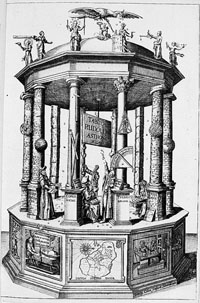Kepler and Poetry
Kepler wrote numerous poems which were printed as prefatory material in his publications. Privately too, he was wont to compose poems and inscribe them in his books, for instance in his own copy of Copernicus' On the Revolutions or in an emblem book. A touching poem in memory of his dead wife and son is also extant. Perhaps the most famous poem associated with Kepler is the one accompanying the frontispiece of the Rudolphine Tables (1627). The picture was designed by Kepler and engraved in a more elaborate form by Georg Celer of Nuremberg. The poem was written by Johann Baptist Hebenstreit (rector of the Ulm gymnasium) and entitled the Idyllion (which means a highly wrought, descriptive poem, usually on a pastoral theme). It describes well the meaning of the frontispiece and Kepler's view of the history of astronomy. The frontispiece of the Rudolphine Tables (1627).
The frontispiece of the Rudolphine Tables (1627).Image by kind permission of the Master and Fellows of Trinity College, Cambridge.
The picture is of the temple of Urania, the muse of astronomy, and it depicts the progress of the discipline of astronomy through history. Mindful of the fact that the Tables were originally Brahe's project, and in order to appease his heirs, Kepler makes the figure of Tycho Brahe take centre stage. Tycho, in his ermine robe, wearing the medal of an elephant (the highest award from the Danish crown), proudly points out his cosmological model (the earth in the centre of the universe with the sun orbiting around earth, but all the other planets orbiting around the sun) to the seated Copernicus. The title of the book, Rudolphine Tables, hangs down proudly from that cosmological model, possibly an allusion to Tycho's wish that the tables be based on his system. At Tycho's elbow is his book on planetary theories, the Progymnasmata. Tycho is leaning on an elegant Corinthian column, complete with an achanthus-leaf capital, which proudly displays his instruments, the quadrant and the sextant that perfected observations. The columns that support the temple symbolize by their form and condition the state of astronomical observation through history. The starry heaven is depicted on the floor of the base because it is the foundation on which the observations (columns) are built. Copernicus' column is of a much simpler form, carrying a Jacob's staff and the parallalactic ruler which induced some careless errors in Copernicus' observations. On the column rest also the observations of Regiomontanus and Walther which aided Copernicus' work.
The firm, but less elegant columns made of bricks with plenty of cracks flank Brahe and Copernicus and signify the achievements (from left to right) of Aratus, Hipparchus, Ptolemy and Meton. Aratus (4th c. BC) wrote a poem entitled the Phaenomena which explained the configuration of the heavens and their movements; his column sports an armillary sphere. Hipparchus improved on Aratus with a sphere of fixed stars and a catalogue of them. Ptolemy is depicted with an astrolabe, drawing a diagram. Part of the Greek title of his book, the Almagest, is visible. At the foot of the column is the diagram of a deferent whose centre was removed from the earth. Meton's column shows a dial, showing the Metonic cycle indispensable for calculating the date of Easter. It shows the nineteen-year cycle after which the lunar phases will recur on the same date. At the back, there are two columns made of tree trunks, with stumps, implying the absence of instruments to render them into more elegant shapes. They do not quite reach the heavenly roof, so Kepler has inserted some wedges. In front of these columns stands a Chaldaean astronomer, trying to gauge the angular distance of planets using his fingers.
On top of roof of the Temple are six goddesses, signifying the important elements of Kepler's astronomy. From left to right, they are optics (the shining head of the goddess is creating a shadow of a globe), the telescope, logarithms (holding in her hands rods of the ratio of one to two, and the number around her head showing the natural logarithm of 2: 0.6931472), geometry (with a compass, square-ruler and a diagram of an ellipse), 'stathmica' namely the laws of the lever and balance (the sun at the fulcrum of the balance shows that this is describes Kepler's area law), and magnetics (holding a lodestone and compass). At the summit of the temple is the imperial eagle with his sceptre, showering a few gold coins down to the astronomers. Tycho's island of Hven is depicted in the centre panel of the base. To its left is a portrait of Kepler, with a miniature of the temple and a list of his books. To the right is a portrait of the printer.